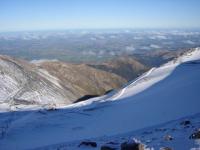Home-Ashburton’s treasures
- Our team
- Research process
- References and acknowledgements
- Tinwald School
- Lake Hood
- Somerset Building
- Ashburton Railway Station
- Plains Railway
- Clock Tower
- Ashburton Museum
- Ashburton Domain
- Water - The Life Blood of the Plains
- Ashburton Bridge
- People Treasures
- Astounding Activities
- Green and Gold Ashburton
- Mount Hutt Skifield - Methven
- Our Rivers
- Baring Square West
- Rakaia Salmon
- Ashburton Guardian
Water - The Life Blood of the Plains
Water - The Life Blood of the Plains
|
The Canterbury Plains and Ashburton as seen from Mt Hutt Ski field Crop farming in the Ashburton region started in 1866 and we now produce 50% of New Zealand's grain (Wheat, barley and oats), and 60% of the country's small seed production (carrot and grass seeds). We also grow a lot of crops like corn, broad beans, borage and clover. |
|
| The problem is that Canterbury lives in the shadow of the Southern Alps, and so it doesn't rain very much. This means our farmers have to irrigate the land to keep the crops wet and help them grow. |
Water facts from Canterbury
|
| So irrigition is very important to Mid-Canterbury, especially now that there are so many dairy farms in the area, and cows need to eat and drink a lot of water to produce milk. | |
| The Rangitata Diverson Race
|
|
|
|
This is a model from the Ashburton Museum showing how the Border Dyke irrigation works. Water flowing down a creek is diverted by a gate and the water floods the grass below.
|
|
|
|
| K-Line are black pods that are linked by a hose. They can be moved by dragging them behind a motor bike. | This is what they look like from close up. It is similar to a normal hose hold sprinkler. |
|
|
|
| This is another form of irrigation. It is a Roto-Rainer. They are really wide (nearly 100m and pull themselves up the paddock on a long wire rope. | This is a Centre Pivot Irrigator. It circles the whole farm from the middle, and sometimes even goes over houses and other buildings. |










